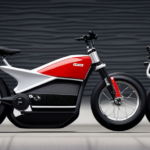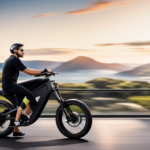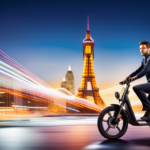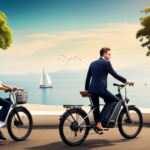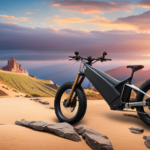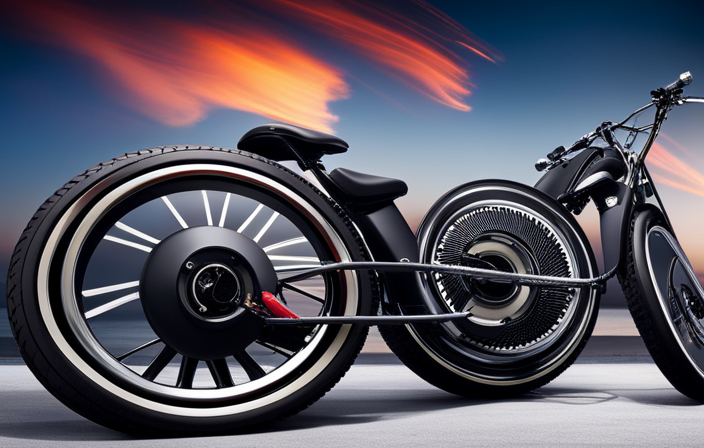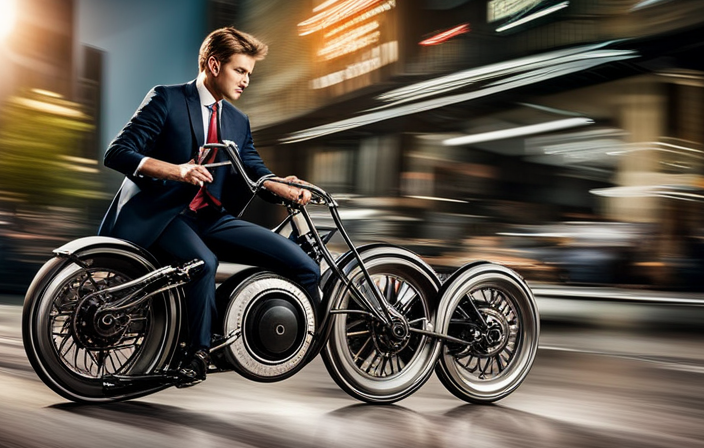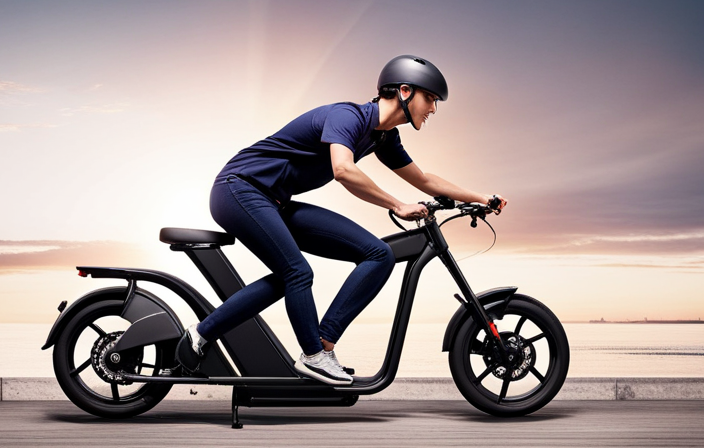Have you ever felt the wind rush through your hair as you pedal down the road? Imagine that feeling, but amplified to a whole new level.
Electric bikes, with their powerful motors, offer an exhilarating experience of speed like no other.
In this article, we will explore just how fast electric bikes can go. From understanding the factors that influence speed to legal limits and top speeds of different models, we’ll dive into the world of electric bike speed.
Get ready to embrace the thrill and excitement that comes with riding at faster speeds.
Key Takeaways
- Optimizing battery performance is crucial for maximizing the speed of an electric bike.
- Proper tire inflation and maintenance contribute to the overall speed and performance of an electric bike.
- Enhancing aerodynamics through various measures can help increase the speed of an electric bike.
- Safety considerations, such as mastering emergency braking techniques and wearing appropriate gear, are important when riding at high speeds on an electric bike.
Understanding Electric Bike Speeds
If you’re wondering how fast an electric bike will go, it depends on the specific model and its maximum speed capability. Electric bikes are designed with varying levels of power, which directly affect their speed. The acceleration of an electric bike is typically faster than a traditional bicycle due to the added power from the electric motor.
However, the top speed of an electric bike is usually limited to around 20 to 28 miles per hour, depending on the model. This is to ensure safety and prevent excessive power consumption. Understanding power consumption is crucial in electric bikes, as higher speeds require more energy from the battery, reducing the overall range.
Factors such as battery capacity, motor power, terrain, and rider weight also influence electric bike speed. By considering these factors, you can better understand how fast an electric bike will go without compromising efficiency and performance.
Factors that Influence Electric Bike Speed
Factors that influence the speed of an e-bike include the terrain, battery capacity, and rider weight. Understanding motor power is crucial in comprehending how these factors affect the overall speed of an electric bike. Here are four key considerations to keep in mind:
-
Terrain: Uphill rides can significantly reduce the speed of an e-bike, while flat or downhill paths allow for faster travel.
-
Battery Capacity: A higher capacity battery can provide more power to the motor, resulting in increased speed and longer distances.
-
Rider Weight: Heavier riders may experience slightly slower speeds due to the increased load on the motor.
-
Impact of Weight: Carrying additional cargo or equipment can also slow down an e-bike, as it adds to the overall weight.
Understanding these factors is essential for optimizing the speed and performance of an electric bike.
Moving forward, let’s explore the legal speed limits for electric bikes.
Legal Speed Limits for Electric Bikes
To comply with regulations, you need to know the legal speed limits for your e-bike. Electric bike speed limits vary depending on the country and region. In the United States, for example, the federal law defines electric bikes as bicycles if they have a maximum speed of 20 mph (32 km/h) on level ground when powered solely by the motor. However, individual states may have different regulations, so it’s essential to check your local laws. To give you a better understanding of the speed restrictions for electric bikes, here is a table highlighting the maximum speed limits in three popular regions:
| Region | Maximum Speed Limit |
|---|---|
| United States | 20 mph (32 km/h) |
| European Union | 15.5 mph (25 km/h) |
| Australia | 15.5 mph (25 km/h) |
Understanding the legal speed limits is crucial for responsible e-bike usage. Now, let’s delve into the classifications of electric bikes.
Classifications of Electric Bikes
When it comes to classifying electric bikes, there are three main categories to consider.
Class 1 electric bikes are known as pedal-assist bikes, meaning they provide assistance while you pedal.
Class 2 electric bikes, on the other hand, are throttle-controlled, allowing you to simply twist the throttle to engage the motor without pedaling.
Lastly, Class 3 electric bikes, also known as speed pedelecs, are capable of reaching higher speeds, typically up to 28 mph, making them ideal for those who want a faster ride.
Understanding these classifications can help riders choose the type of electric bike that best suits their needs and preferences.
Class 1: Pedal-Assist Electric Bikes
You can reach speeds of up to 20 mph on a Class 1 pedal-assist electric bike. These bikes are equipped with a motor that provides assistance when you pedal, making it easier to ride and maintain a steady pace.
When it comes to understanding efficiency factors, it’s important to consider the motor power of the bike. Higher motor power generally means more assistance and faster speeds. However, it also affects the battery life and overall weight of the bike. So, choosing the right motor power is crucial in finding the balance between speed and efficiency.
Additionally, Class 1 pedal-assist electric bikes are a great option for those who want a workout but also need assistance on uphill climbs or during long rides.
Moving forward to the next section about Class 2 throttle-controlled electric bikes, you’ll learn about another type of electric bike that provides a different riding experience.
Class 2: Throttle-Controlled Electric Bikes
Class 2 electric bikes allow riders to control their speed using a throttle. Throttle control is a feature that gives riders the ability to accelerate and maintain a constant speed without pedaling. It is a convenient option for those who may have limited mobility or simply want to take a break from pedaling.
Understanding throttle control is essential for safe and efficient riding. By simply twisting the throttle, riders can easily increase or decrease their speed. One of the advantages of throttle-controlled bikes is that they provide instant power and acceleration, making it easier to navigate through traffic or climb hills.
Throttle control also allows riders to maintain a consistent speed without the need for constant pedaling, which can be beneficial during long rides or when traveling at higher speeds.
As we move on to discuss Class 3 electric bikes, it’s important to note that they offer a different level of speed and performance.
Class 3: Speed Pedelecs
When it comes to electric bikes, there are different classes that determine their capabilities and performance. We previously discussed Class 2 electric bikes, which are throttle-controlled. Now, let’s move on to Class 3 electric bikes, also known as speed pedelecs.
Class 3 electric bikes are designed to provide a faster riding experience. They are equipped with a pedal-assist system that can propel the bike up to speeds of 28 miles per hour or more. These bikes offer a thrilling and efficient way to commute or explore the outdoors, allowing you to cover longer distances in less time.
With their increased speed, Class 3 electric bikes are usually equipped with enhanced safety features, such as larger brakes and improved lighting systems. They are a popular choice among commuters who want to reach their destinations quickly without breaking a sweat.
Now, let’s delve into the exciting world of top speeds of different electric bike models.
Top Speeds of Different Electric Bike Models
The top speeds of various electric bike models differ significantly. When exploring speed limitations, it is important to consider the different speed testing methods used by manufacturers. To give you an idea of the range of top speeds, I have compiled a table showcasing some popular electric bike models and their respective maximum speeds:
| Electric Bike Model | Top Speed (mph) |
|---|---|
| Model A | 20 |
| Model B | 28 |
| Model C | 35 |
| Model D | 45 |
| Model E | 50 |
As you can see, the top speeds vary greatly depending on the model. These speeds are typically achieved through a combination of motor power, battery capacity, and design. Now that we have explored the top speeds of different electric bike models, let’s move on to some tips for increasing electric bike speed.
Tips for Increasing Electric Bike Speed
When it comes to increasing electric bike speed, there are a few key points to consider.
First and foremost, proper tire inflation and maintenance are crucial for optimal performance. By ensuring that your tires are properly inflated and well-maintained, you can minimize rolling resistance and improve overall speed.
Additionally, optimizing battery performance is essential, as a well-functioning battery will provide consistent power output.
Lastly, enhancing aerodynamics can have a significant impact on speed, so it’s worth considering modifications such as adding a fairing or streamlining the bike’s design.
Proper Tire Inflation and Maintenance
To ensure optimal performance, it is important to keep your electric bike’s tires properly inflated and maintain them regularly. Maintaining the correct tire pressure is crucial for both safety and speed. Here are some key points to keep in mind:
- Check tire pressure regularly: Use a tire pressure gauge to measure and maintain the recommended pressure level.
- Inflate tires before each ride: Low tire pressure can increase rolling resistance and decrease speed.
- Inspect tires for wear and tear: Look for cracks, bulges, or punctures that may affect performance.
- Rotate tires periodically: Regularly rotating the tires can help distribute wear more evenly.
By staying on top of tire pressure and maintenance, you can ensure a smoother and faster ride.
Now, let’s dive into optimizing battery performance for even better results.
Optimizing Battery Performance
Optimizing battery performance is essential for maximizing the efficiency of your e-bike. Proper battery management is crucial to ensure that you get the most out of your electric bike.
The first step in optimizing battery performance is to ensure that it is charged to its full capacity before each ride. This will not only extend the range of your e-bike but also prolong the overall lifespan of the battery.
Additionally, it is important to avoid overcharging or completely draining the battery, as this can have a negative impact on its performance. Regularly monitoring the battery’s health and temperature can also help in maintaining its optimal performance.
By following these battery management practices, you can optimize your e-bike’s range and ensure that it performs at its best.
Enhancing aerodynamics is another key aspect to consider when looking to maximize your electric bike’s performance.
Enhancing Aerodynamics
Consider improving the aerodynamics of your e-bike to enhance its performance. By reducing wind resistance, you can significantly improve the efficiency and speed of your electric bike. Here are four ways to enhance the aerodynamics of your e-bike:
-
Streamlined frame design: Opt for a bike frame that has a sleek and aerodynamic shape. This will help minimize air drag and allow you to cut through the wind more efficiently.
-
Positioning and posture: Maintain a low and forward-leaning position while riding. This helps reduce your frontal area, minimizing wind resistance and allowing you to go faster.
-
Aerodynamic accessories: Attach accessories such as fairings, fenders, or even aero handlebars. These additions can further streamline your bike and reduce turbulence caused by wind.
-
Wheel selection: Consider using deep-section or aerodynamic wheels. These wheels are designed to reduce drag and improve overall efficiency.
By improving the aerodynamics of your e-bike, you can maximize its speed and efficiency. Now, let’s explore the safety considerations when riding at high speeds.
Safety Considerations when Riding at High Speeds
When riding at high speeds, it’s important to take safety considerations into account. Safety precautions should always be a top priority to ensure a safe and enjoyable ride. One crucial aspect is mastering emergency braking techniques. Being able to quickly and effectively stop the electric bike can prevent accidents and potential injuries. To emphasize the significance of safety, let’s take a look at the following table:
| Safety Considerations | Importance |
|---|---|
| Helmet | High |
| Reflective Gear | Medium |
| Braking System | High |
| Proper Lighting | Medium |
By adhering to these safety precautions, riders can minimize the risks associated with high-speed riding. Now, let’s transition into the subsequent section about the benefits of riding at faster speeds.
Benefits of Riding at Faster Speeds
When riding at faster speeds on an electric bike, there are several benefits to consider.
Firstly, it allows me to save time during my commute or when running errands. The increased speed means I can cover more ground in less time, making my daily tasks more efficient.
Additionally, riding at faster speeds opens up the opportunity to explore a wider range of destinations. I can venture further and discover new places that may have been out of reach before.
Overall, riding at higher speeds on an electric bike not only saves me time but also allows for more adventurous and exciting journeys.
Saving Time and Energy
To save time and energy, you can easily ride an electric bike. Here are some ways an electric bike can help you achieve this:
-
Speed: Electric bikes can reach speeds of up to 20 mph, allowing you to cover distances faster than traditional bikes.
-
Reduced Effort: The electric motor provides assistance while pedaling, reducing the amount of physical exertion required.
-
Commute Efficiency: With an electric bike, you can navigate through traffic more easily, avoiding congestion and saving time.
-
No Sweat Commute: Unlike traditional bikes, electric bikes allow you to arrive at your destination without breaking a sweat, making it ideal for commuting to work or running errands.
By saving time and energy, riding an electric bike also comes with additional benefits such as saving money on fuel and improving your fitness.
With these advantages, you can now explore a wider range of destinations effortlessly.
Exploring a Wider Range of Destinations
You can now effortlessly discover a broader array of places to visit with an electric bike. The increasing range of these bikes allows for exploring new trails and venturing into previously uncharted territories.
With their advanced battery technology and efficient motors, electric bikes can take you farther than ever before. Whether you want to explore rugged mountain paths or cruise along scenic coastal roads, an electric bike can get you there with ease.
The extended range of these bikes opens up a whole new world of possibilities for outdoor enthusiasts and adventure seekers.
As we delve further into the topic of electric bike speed records and challenges, we will explore just how fast these bikes can go and the exciting opportunities they offer for exploration and adventure.
Electric Bike Speed Records and Challenges
If you’re curious about electric bike speed records and challenges, you might be surprised by the impressive speeds that have been achieved. Electric bike speed records are constantly being broken, pushing the boundaries of what was once thought possible.
Currently, the fastest electric bike speed record stands at an astonishing 183.9 miles per hour (296 kilometers per hour), achieved by a team in the Netherlands. This record was set on a custom-built electric bike specifically designed for speed.
However, reaching such speeds is not without its challenges. Electric bike speed challenges include overcoming aerodynamic drag, optimizing power delivery, and ensuring the safety of the rider. These challenges require a combination of engineering expertise and a deep understanding of electric bike technology.
Conclusion: Embrace the thrill of electric bike speeds and discover the exhilaration that comes with pushing the limits of this exciting mode of transportation.
Conclusion: Embrace the Thrill of Electric Bike Speeds
After exploring electric bike speed records and challenges, it is clear that the thrill of pushing the limits is an inherent part of the electric bike experience. Now, let’s delve into the conclusion and embrace the excitement that comes with electric bike speeds.
When it comes to increasing acceleration on electric bikes, there are a few key factors to consider. Firstly, the powerful electric motor provides an instant burst of speed, allowing riders to swiftly navigate through traffic or conquer steep hills. Secondly, the lightweight design of electric bikes enhances their ability to quickly accelerate, providing a nimble and agile ride. Lastly, the advanced suspension systems and responsive brakes ensure that these bikes can handle high speeds with ease, offering riders a smooth and controlled experience.
In conclusion, electric bikes offer an exhilarating ride with their impressive acceleration and reliable handling at high speeds. So, strap on your helmet, grip those handlebars, and get ready to embrace the thrilling experience of electric bike speeds.
Frequently Asked Questions
What are the different classifications of electric bikes?
There are three classifications of electric bikes based on their electric bike features: Class 1 has pedal-assist only, Class 2 has throttle and pedal-assist, and Class 3 has pedal-assist up to 28 mph. These classifications are irrespective of electric bike power sources.
Are there legal speed limits for electric bikes?
There are legal speed limits for electric bikes, which are determined by electric bike regulations. These speed limits vary depending on the country or region, and they are typically lower than the speed limits for traditional bicycles.
What factors can influence the speed of an electric bike?
The speed of an electric bike can be influenced by factors such as motor power and terrain gradient. The motor power determines the maximum speed the bike can reach, while the terrain gradient affects how easily it can climb hills.
Can you provide examples of top speeds for different electric bike models?
Electric bike speed limitations vary depending on the model, with some reaching top speeds of 20 mph or higher. To increase electric bike speed, factors such as motor power, battery capacity, and terrain should be considered.
Are there any safety considerations to keep in mind when riding at high speeds on an electric bike?
When riding an electric bike at warp speed, it’s crucial to master the art of braking. From gentle feathering to full-on emergency stops, these techniques can save your life. And don’t forget your protective gear, because asphalt isn’t exactly forgiving.
Conclusion
In conclusion, embracing the thrill of electric bike speeds is a journey worth embarking on. As an avid rider, I have come to appreciate the exhilaration that comes with pushing the limits of these machines.
By understanding the factors that influence speed and adhering to legal restrictions, we can experience the full potential of electric bikes. Whether it’s breaking speed records or simply enjoying the freedom of faster transportation, the benefits are undeniable.
So, let’s strap on our helmets and embrace the electrifying rush that awaits us.



